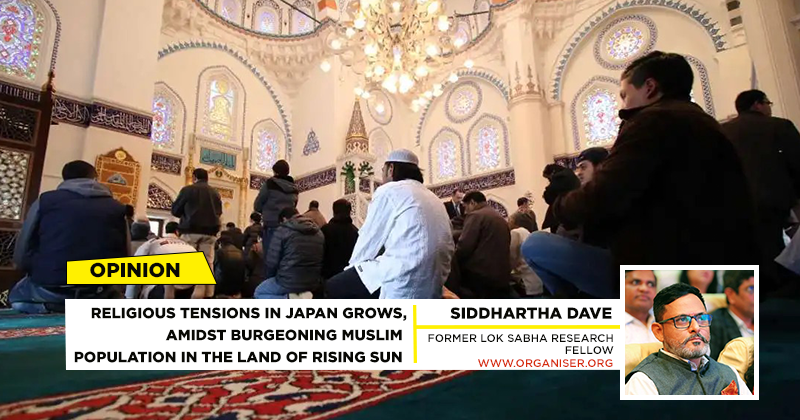The Muslim population in Japan has been gradually increasing over the years, although it remains relatively small compared to other religious groups in the country. It is important to note that official statistics on religious affiliation in Japan do not include data on Islam specifically, so determining the exact size of the Muslim population can be challenging. Nonetheless, various estimates and observations shed some light on its growth.
The mushrooming of the Muslim population in Japan can be attributed to several factors. Firstly, an increase in international migration and globalisation has led to a rise in the number of Muslims residing in Japan. This includes foreign students, workers, and their families from predominantly Muslim countries, as well as refugees and asylum seekers. It is interesting to note that, Muslim refugees, mostly from Syria and asylum seekers are not accepted by countries like United Arab Emirates, Qatar, Kuwait, and Malaysia.
According to June 2022 report of Norwegian Refugee Council, these Arab nations do not come under the top ten refugee receiving countries.
Second, main reason for increasing population of Muslims in Japan is growing conversion. Some Japanese people have embraced Islam due to intermarriage with Muslims, or exposure to Islamic cultures during travel or study abroad experiences.
Japan’s religious landscape is changing dramatically. This is becoming more evident by the rise in the number of mosques that have appeared there during the past 20 years. The concentration of Muslims is higher in urban areas, particularly Tokyo, Osaka, and Yokohama, where mosques, halal restaurants, and other facilities catering to Muslim needs are burgeoning.
The Japanese government and various organisations have been working to accommodate the needs of the Muslim community, such as providing prayer spaces, halal food options, and improving awareness about Islamic practices. However, there are still some challenges faced by Muslims in Japan, including language barriers, cultural differences, and limited social support networks.
In 2000 Muslim population in Japan was estimated to be 20,000 only. One estimate suggests this number to be anywhere around 200,000. That is a ten-fold increase in less than one generation. Additionally, mosques, formerly a rare sight in Japan, are become more widespread. There were more than 113 mosques in Japan as of March 2021, up from only 15 in 1999.
While, this author was a research fellow at United Nations University, Tokyo in 2009, he found Japanese culture to be very friendly, but introvert to external expressions. While this trend reflects a more inclusive Japanese society, it also presents challenges and friction.
Last week, a disturbing incident occurred when a Muslim immigrant from Gambia dressed in an Arabic robe destroyed a Japanese Shinto temple, breaking sacred jijo statues, and was seen confronting women. The fanatic was seen screaming chilling statement, “There is only one God, the Allah, and here, there is no God.” Everything was recorded, and the video quickly became viral online. This created ripples amongst the twitteratis in Japan.
“Having firm convictions might occasionally make us oblivious to our environment and result in rigid thinking.
It can make us unwilling to consider alternative viewpoints, which can cause conflict. Islam serves as a prominent illustration of this phenomenon”, read one comment. One more remark was that “allowing other people’s views” is the foundation for Japan’s provision of the fundamental human right known as “freedom of religion.” We cannot coexist with those who criticise other people’s views because they do not share our principles. Another comment stated that Islam seeks to Dar-ul Islam. Nothing about this fits with the style of thinking that has been ingrained in Japan from the beginning of time. Here, I have deliberately picked the remarks that were not too provocative.
Islam and Shintoism are two distinct religions with different beliefs, practices, and cultural contexts. Muslims believe in the absolute oneness of God, Allah. Shintoism-an indigenous religion to Japan, on the other hand, does not have a single conception of God. Instead, it centers around the veneration of kami, which are revered as divine beings or spirits. Kami can represent various aspects of nature, such as mountains, rivers, trees, and also include ancestral spirits and deities associated with certain activities or professions. Shinto is noteworthy for its propensity to accept other faiths and for claiming itself to be a religion with eight million gods, among other things. This closely resembles the Sanatan Dharma. Many theological experts also think that Shintoism’s roots are in Hinduism.
However, from the viewpoint of an immigrant Muslim in Japan, this peaceful cohabitation becomes impossible. Islamic monotheism and the Shinto idea of polytheism are mutually incompatible. Islam places a strong emphasis on the unity of God and outright forbids the worship of any other deities.
The concept of peaceful cohabitation between Shinto and Islam might be challenging for Muslims to imagine because of the potential conflict between the two faiths and the differences in their doctrinal philosophies.
The recent act of vandalising the Shinto temple in Japan highlights the challenges in envisioning a peaceful coexistence between these two faiths, in the land of rising sun.
Islamic academics should consider this. Why polytheism and Islam cannot coexist. Why Shia and Sunni Islam are incompatible. Why neither can coexist with Ahmedias. Will they sincerely ponder on these questions?




















Comments